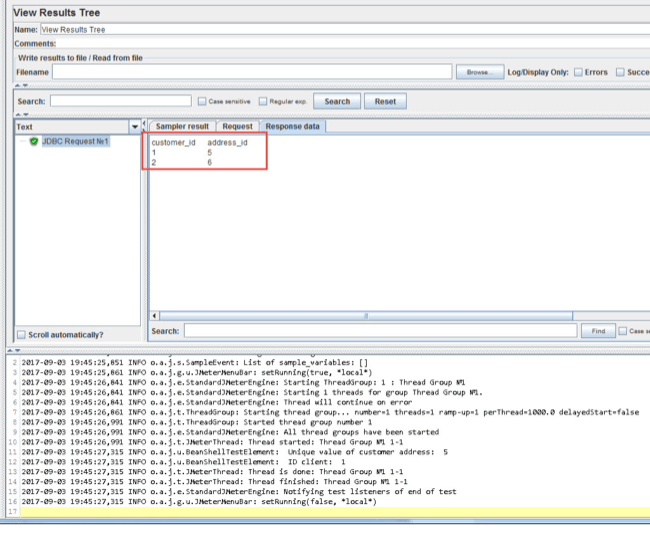This Demonstration implements a binary listed tree , a knowledge construction used primarily to calculate prefix sums in an inventory efficiently. To compute the sum of the values in a variety of the list, transfer the beginning and finish sliders to specify it. Hover over the entries within the "tree" row to see which parts within the listing are contained in that node. The proposal is predicated on the indisputable proven actuality that each one optimistic integers should be represented because the sum of powers of 2.
For instance 19 might be represented as sixteen + 2 + 1. Every node of the BITree shops the sum of n parts the place n is an influence of 2. For example, within the primary diagram above (the diagram for getSum()), the sum of the primary 12 parts might be obtained by the sum of the final four parts plus the sum of eight parts . The variety of set bits within the binary illustration of a variety n is O. Therefore, we traverse at-most O nodes in equally getSum() and update() operations.
The time complexity of the development is O because it calls update() for all n elements. Given a static reference string R and a supply string S, a relative compression of S with respect to R is an encoding of S as a sequence of references to substrings of R. We provoke the examine of relative compression in a dynamic setting the place the compressed supply string S is subject matter to edit operations. The aim is to take care of the compressed illustration compactly, when supporting edits and permitting effective random entry to the supply string.
We additionally current options for restricted and prolonged units of updates. To acquire these results, we revisit the dynamic partial sums drawback and the substring concatenation problem. We current new optimum or close to optimum bounds for these problems. Plugging in our new consequences we additionally promptly acquire new bounds for the string indexing for patterns with wildcards drawback and the dynamic textual content and static sample matching problem. A Fenwick tree or binary listed tree is a knowledge shape that helps compute prefix sums efficiently.
Computing prefix sums are sometimes valuable in numerous different algorithms, to not say a number of aggressive programming problems. For example, they're used to implement the arithmetic coding algorithm. Fenwick timber have been invented by Peter M. Fenwick in 1994. A new procedure (the 'binary listed tree') is introduced for sustaining the cumulative frequencies that are necessary to assist dynamic arithmetic information compression.
It is predicated on a decomposition of the cumulative frequencies into parts which parallel the binary illustration of the index of the desk aspect . The operations to traverse the info shape are established on the binary coding of the index. In comparability with earlier methods, the binary listed tree is faster, employing extra compact facts and easier code. The entry time for all operations is both fixed or proportional to the logarithm of the desk size.
In conjunction with the compact facts structure, this makes the brand new way significantly proper for giant image alphabets. A Fenwick tree or binary listed tree is a knowledge shape which will effectively replace components and calculate prefix sums in a desk of numbers. This shape was proposed by Peter Fenwick in 1994 to enhance the effectivity of arithmetic coding compression algorithms. Time complexity of the development is O because it calls update() for all n elements. If the binary operation utilized by selection queries helps subtraction, we will reply a question with the big difference of two prefix sums sum - sum, and accordingly change to a Fenwick tree .
Unlike a phase tree (2n-1 nodes), a Fenwick tree wants precisely n elements. It's really an array other than an actual tree. In particular, we think of the relevant case the place there are various such queries to the identical array, A, which resides fully in RAM. For bigger values of n, we arrive on the shocking conclusion that the Eytzinger structure is generally the fastest.
Our quickest C++ implementations, when compiled, use conditional strikes to steer clear of department mispredictions and prefetching to scale back cache latency. This matches worthwhile regarded time bounds for the issue whilst enhancing the area from superlinear to a continuing variety of ultrawords. Our outcomes are primarily based on an easy and stylish in-place phrase RAM info structure, which is called the Fenwick tree. Our essential technical contribution is a brand new effective parallel ultra-wide phrase RAM implementation of the Fenwick tree, which is probably going of unbiased interest. Given an integer array A, the prefix-sum drawback is to reply sum queries that return the sum of the weather in A[0..i], figuring out that the integers in A might be changed.
It is a basic obstacle in info shape design with a variety of purposes in computing from coding to databases. If the array is dynamic (insertion/deletion), we will change to a binary search tree which encodes the array in its in-order traversal. For selection queries, a Splay tree and a Treap (with join-based tree algorithms) are common. This library gives you a pure go implementation with an in depth API. Updates and queries are supported on each numbers and prefix sums.
They will be carried out on a single element, a variety of parts or the entire tree. There is not any have to maintain maintain of the numbers array as soon as the BIT is constructed, because the numbers will be calculated from the BIT. If required, the Fenwick tree can re-use the numbers array, avoiding reminiscence allocations for the duration of BIT construction. A Fenwick tree performs each operations in O time. The tree is generally embedded in a 1-based array, with the youngsters of node i at nodes 2i and 2i + 1. Each component with index i an influence of two accommodates the sum of the primary i elements.
Each aspect with index i a sum of two powers of two consists of the sum of the weather because the previous potential of 2. In general, every aspect consists of the sum of the values since its mum or dad within the tree, discovered by clearing the least-significant bit within the index. Wikipedia has an outstanding description of Fenwick trees. Let's say we've an array with n parts a,a,...,a[n-1]. There are vary modifications and vary queries.
Out phase tree shops the weather in its leaf nodes, supporting selection modifications and selection queries in O(log) time. We could make an in-order traversal at any time to retrieve the up to date array. Range Update and Point Query Suppose that we wish to increment the interval by x.
We make two level replace operations on Fenwick tree that are add and add(r+1, -x) . If we wish to get the worth of A, we simply must take the prefix sum employing the standard variety sum method. If we question the sum of a variety of consecutive numbers in an array, it takes O time on average, by including up the numbers. Alternatively, we will make the most of a second array to save lots of the prefix sums, for this reason the question should be finished in O time, however updating the weather turns into an O operation.
Therefore, a Fenwick tree is most well-liked when parts mutate frequently. The replace perform must ensure that each one the BIT nodes which comprise arr inside their ranges being updated. We loop over such nodes within the BIT by repeatedly including the decimal variety akin to the final set little bit of the present index. Notice that the import parameter is the 'delta value' not an absolute value. Given an integer array A, the prefix‐sum downside is to reply sum queries that return the sum of the weather in A[0..i], figuring out that the integers in A might be changed. In this work, we suggest and examine functional options to this problem, displaying that new trade‐offs ...
Here N denotes the variety of parts current within the array. Maximum variety of steps that we'll must iterate for replace and question process is higher bounded by the variety of bits within the binary illustration of the dimensions of the array . And there are at most logN set bits in a binary illustration of a wide variety N. So the higher sure needs to be logN for each the operations on the info structure.
We repeat this course of till the ensuing index goes past the array. It was proposed by Peter M. Fenwick and was first used for info compression. In algorithmic contests it really is usually used to unravel particular varieties of variety queries, on ranges from a root to some distant node or calculation of prefix sum of array extra efficiently.
Binary Indexed Tree is represented as an array. Each node of the Binary Indexed Tree shops the sum of some components of the enter array. The measurement of the Binary Indexed Tree is the same as the dimensions of the enter array, denoted as n. In the code below, we use a measurement of n+1 for ease of implementation.
Given a desk of elements, it really is usually fascinating to calculate the operating complete of values as much as every index in response to some associative binary operation . When n is just not an influence of two, the node at index one shops the monoid sum of a permutation of the entire array. Subtree 2 not aggregates components zero to n/2-1 and subtree three not combination components n/2 to n-1.
The above top-down stroll code might be incorrect. Binary Indexed Tree additionally called Fenwick tree is a knowledge shape presenting useful strategies for calculation and manipulation of the prefix sums of a desk of values. The ahead computation of indexes need to change into clear with the above diagram.
For example, when updating the worth at index , we have to replace prefix sums for indexes in FTree[] array. Similarly for index , we have to do that for indexes . Basically replace all of the nodes alongside the trail to dummy root node. Maintain an auxiliary array of similar measurement and keep the prefix/cumulative sums.
Let's say the auxiliary array is prefixsum[]. So prefixsum is the cumulative sum of components in array from index to index . The prefix sum of an inventory in a selected index is the sum of all the weather within the record as much as and along with that index. This algorithm accelerates the computation of prefix sums when the list's gadgets can change; there are extra environment friendly algorithms to compute prefix sums of static lists. A Fenwick tree is an easy information construction to unravel this problem. Construction takes O time, however a BIT balances each the sum question and aspect replace operations, performing no worse than O time.
This article lined the Binary Indexed Tree or Fenwick Tree. We have discovered concerning the appliance of the binary listed tree to unravel issues just like the selection sum or prefix sum of an array efficiently. As any integer might possibly be represented because the sum of powers of two ( i.e., the theory of binary representation).
So, for any index of a binary listed tree array, we will discover a variety of indices whose summation might be saved at that index. Having this tree shape with us, it can be to seek out sum of parts until any index. The inspiration is to maintain a variable ans initialized to 0.
Follow the trail from root to the index node. Whenever we have to comply with a good link, add the worth of existing node to ans. Then we'll divide ther interval into halves and the 2 youngsters of the basis will characterize [0,n/2) and [n/2,n). For every node we look at various regardless of whether the size is bigger than 1, and divide the interval into halves. The tree array can solely question the prefix sum and single-point modification. We can arrange a distinction array d[] and preserve it with the tree-shaped array, then the interval modification turns into a single-point modification.
If you add a okay within the interval of , then add,add(r+1,-k). This completes the upkeep of the big difference array. If you question the worth at x at a single point, you simply want a + ask. A BIT or Fenwick Tree is a knowledge construction offering useful techniques for calculation and manipulation of the prefix sums of a desk of values. Oh, you misunderstand what tree shops even within the purpose update-range question case.
Tree doesn't retailer the matter of values 5 and 6 within the entire array. It shops the sum of values at array indices 5 and 6. Given an array A of N numbers, we have to assist including a worth v to any component A and querying the sum of numbers A + A[a+1] + … + A, every operations in O. Let ft[N+1] denotes the underlying fenwick tree. A binary search tree is a binary tree that could be empty. An listed BST is derived from a BST by including a field, LeftSize, to every tree node, whose worth is the variety of nodes in its left- subtree plus 1.
Fenwick tree is a tree established info shape that's commonly used to unravel variety question issues in logarithmic time O which might in any different case have taken linear time O. In this article, we've defined it in depth making use of the variety product question problem. The purpose why that is very vital to us is, our sum and replace operations will rely on the this path. During a sum, we simply care concerning the left hyperlinks we follow. During an update, we simply care concerning the fitting hyperlinks we follow. This binary listed tree does all of this tremendous effectively by simply making use of the bits within the index.
The replace operate must be certain that each one the BITree nodes which include arr inside their ranges being updated. We loop over such nodes within the BITree by repeatedly including the decimal wide variety akin to the final set little bit of the present index. You can get O amortized querying and updating (including removing/inserting elements) employing a Binary Indexed Tree, additionally called a Fenwick tree. The inspiration is to make use of dynamic resizing, which is identical trick utilized in variable-size arrays and hash tables to get amortized fixed time appends.
The means we keep these partial sums in a Binary Indexed Tree , a.k.a. Fenwick Tree, makes it possible for us to realize equally the replace and question to be accomplished in logarithmic time. Speaking of partial sum of sequences like question sum, you are able to assume about cumulative sum. In fact, in the event you put together an array that's the cumulative sum of the sequence $ a $, the question sum should be processed with $ O $.




















































